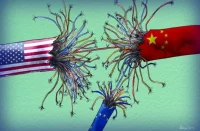Over the past four decades of implementing Deng Xiaoping’s ideas, China has taken a giant leap in economic, technological and military-political development. It has become the second economic power in the world, inferior to the United States only, and in terms of GDP based on purchasing power parity, it ranks No. 1.
Since the end of the Cold War in the early 1990s and until the Trump administration came to power, the U.S. stance on Beijing had been based on several conflicting but well-balanced policies. On the one hand, recognizing the benefits of trade and economic partnership with Beijing, the Americans proceeded from the fact that it was necessary to develop cooperation with such a major power on a wide range of issues while gradually dragging China into the liberal world order. On the other hand, Washington was concerned about the growth of Chinese military power, incompleteness of its market reforms, disproportionately high role of the state in its economy, non-transparency, human rights situation and undemocratic state-political system isolated from external influence, i.e. from the West.
All approaches to Beijing changed under the Trump administration, when Washington realized that the hopes for democratizing the Chinese state and transforming it into a full-fledged Western-style market economy were delusive at that stage. Instead of illusions about China’s integration into the American-led international liberal community, Washington had to ‘take a reality check’ and pursue an extremely realistic policy in the spirit of great power rivalry.
That course was worded in 2020 in the White House document titled “US Strategic Approach to China”. That was the first time China was called a country that posed a threat to the economy, security, values and leadership of the United States, and it was mentioned that U.S. policy on China should involve pressure and containment of Beijing to promote American prosperity, protect the state, preserve peace through strength and advance American influence in the world. At the same time, the document stated that competition should not go beyond red lines or turn into confrontation or open conflict. Thus, all Washington’s claims against China can be boiled down to the following:
– China must remain a non-market state. Over-industrialization, protectionism and government tools provide the PRC with advantages that market economies do not have, leading to unfair competition. In addition, the reverse engineering of U.S. technologies, infringements on intellectual property and industrial espionage constitute a threat to U.S. security;
– challenge to American values. China is striving for global leadership, including through the promotion of its state model based on a specific interpretation of Marxism-Leninism, nationalism, one-party dictatorship, directive economy, suppression of human rights and government control over science and technology;
– suppression of opposition, thriving censorship, prejudicing the rights of national minorities in the Xinjiang Uygur Autonomous Region and Tibet;
– security challenges. China has become an influential military power that possesses nuclear weapons. Furthermore, China has become a major player in the digital and information domain.
 Under the Biden administration, U.S. officials began to publicly speak about the possibility of a new cold war with China. The containment of Beijing was enshrined in key doctrinal foreign policy documents and moved into practice in the form of increasingly growing information, trade and economic pressure on China. For instance, in October 2022, the Pentagon referred to the growing China and the still dangerous Russia as the main threats to America’s national security in its updated National Defense Strategy. China was pegged as “the most important strategic competitor for the coming decades.” The Pentagon came to such conclusion based on “the PRC’s increasingly aggressive efforts aimed to restructure the Indo-Pacific region (IPR) and the international security system to match its interests and authoritarian preferences.” The document says that China seeks to undermine U.S. alliances and security partnerships in the IPR and use its growing capabilities, including economic and military ones, together with military presence to coerce its neighbors and threaten their interests. The PRC’s coercive activities against Taiwan destabilize the situation and threaten peace and stability in the Taiwan Strait, in the East China and South China Seas. The concern of the Americans was also raised by Beijing’s “clearly stated intentions” to rapidly upgrade and increase the combat readiness of its armed forces and build up its Air Force and Navy resources and capabilities.
Under the Biden administration, U.S. officials began to publicly speak about the possibility of a new cold war with China. The containment of Beijing was enshrined in key doctrinal foreign policy documents and moved into practice in the form of increasingly growing information, trade and economic pressure on China. For instance, in October 2022, the Pentagon referred to the growing China and the still dangerous Russia as the main threats to America’s national security in its updated National Defense Strategy. China was pegged as “the most important strategic competitor for the coming decades.” The Pentagon came to such conclusion based on “the PRC’s increasingly aggressive efforts aimed to restructure the Indo-Pacific region (IPR) and the international security system to match its interests and authoritarian preferences.” The document says that China seeks to undermine U.S. alliances and security partnerships in the IPR and use its growing capabilities, including economic and military ones, together with military presence to coerce its neighbors and threaten their interests. The PRC’s coercive activities against Taiwan destabilize the situation and threaten peace and stability in the Taiwan Strait, in the East China and South China Seas. The concern of the Americans was also raised by Beijing’s “clearly stated intentions” to rapidly upgrade and increase the combat readiness of its armed forces and build up its Air Force and Navy resources and capabilities.
The U.S. defense establishment plans to avert the threat from the rising rival through an “expanding network of allies and partners” in the region and by building a sustainable security architecture in the Indo-Pacific region that will ensure “free and transparent regional order and deter attempts to resolve conflicts by force.” At the same time, it has voiced its intention to strengthen defense cooperation with Japan, Australia, India, Taiwan and South Korea and emphasized the importance of multilateral cooperation within AUKUS and QUAD and interaction with ASEAN. For instances, it intends to strengthen partnership with Delhi to enhance its “ability to deter China’s aggression” and with Australia “to deepen the alliance through investment, interoperability and expansion of multilateral cooperation.” Benefits are expected to also come from “advanced technology cooperation” within AUKUS. At the same time, cooperation with Tokyo would be strengthened “through a comprehensive alignment of strategic planning and priorities.”
Thus, the USA has set a course for influencing Beijing through Washington’s surrounding allies and partners in the IPR by changing China’s operating environment. It is assumed that China’s military potential will be weakened due to the creation of hostile coalitions and strengthening of competitors in the region. As potential measures to boost involvement in the affairs of the region, the White House is considering “promoting integrated deterrence”, further development of the AUKUS alliance, deepening the five regional alliances with Australia, Japan, South Korea, the Philippines and Thailand, and supporting India’s regional leadership. Western political scientists note that so far, under the auspices of the United States, alliances have not yet become NATO replicas similar to AUKUS, however, their creation is a step in that direction. At the NATO summit hosted by Madrid in June 2022, the North Atlantic Alliance officially announced that its scope of responsibility was becoming global. For example, warships of the UK and France, NATO members, began to regularly visit the South China Sea waters near Taiwan.
As for Washington, they reverted to the idea underlying the 1951 strategy by former U.S. Secretary of State John Dulles, i.e., the ‘island chain strategy’ that envisaged encircling China with naval bases in the western Pacific Ocean to project power and limit its access to the sea, which, in fact, means a naval blockade. The Americans proceed from the fact that 90 per cent of China’s foreign trade takes place by sea involving 10 ports on China’s Pacific coast.
The beginning of 2023 was marked by the strengthening of U.S. military cooperation with Japan, its main ally in the IPR. During Japanese Premier Kishida’s visit to Washington that took place in January, the parties agreed to upgrade the U.S.-Japanese alliance in the new realities of ‘strategic rivalry’ by demonstrating the unity of approaches to containing China. An agreement was reached to deploy a regiment of U.S. Marines armed with anti-ship missiles on the island of Okinawa. The Japanese Ministry of Defense, in turn, proceeded with the construction of a new base for U.S. carrier-based aircraft exercises on the uninhabited Mageshima island. Tokyo also intends to bulk-order 400 Tomahawk cruise missiles from the United States.
The Philippines is another Asian state that has enhanced militarization not without Washington’s help. In early 2023, an agreement was reached enabling American access to four new bases in the Philippines in addition to the five facilities to which the U.S. Armed Forces have access under the Enhanced Defense Cooperation Agreement (EDCA) that allows Americans to send troops to specific bases. In April this year, the countries held Balikatan, the largest joint exercise in 30 years that involved about 18,000 members of the U.S. military. Manila was not shy about the fact that these exercises were carried out in response to the large-scale maneuvers of the Chinese fleet and air force around Taiwan that took place earlier.
That is why the Philippines, along with Taiwan and Japanese Okinawa, is of exceptional importance for Washington, being essentially the first chain of islands surrounding the PRC.
At the same time, the expansion of the U.S. military presence in the region is not limited to bilateral cooperation with Asian allies and participation in multilateral alliances such as AUKUS and QUAD. Such an informal structure as Partners in the Blue pacific created in 2022 aimed at strengthening U.S. diplomatic, economic and military ties with the island states of the South Pacific is worth mentioning as a separate point. It is this area of American policy in pursuance of which a security pact was executed between the United States and Papua New Guinea on June 18 this year in Port Moresby enabling the Americans’ “unhindered access” to six key ports and airports of this Oceanian state, including the Lombrum naval base on Manus Island, and allowing the USA to potentially deploy troops and ships there.
Thus, the IPR has become the arena of the geopolitical struggle between the USA and China. In an attempt to contain the increasingly growing influence of Beijing, Washington is indoctrinating regional players as anti-Chinese as possible thereby facilitating the turning of the region into one of the most explosive hotspots in the world. Currently, neither Beijing nor Washington wants a direct military clash. Such a scenario is rather a hypothetical possibility. This is evidenced by the outcomes of U.S. Secretary of State Blinken’s visit to Beijing in mid-June this year and his meetings with Chinese leaders. However, in the long run, the situation may develop in a more confrontational way since China would not tolerate a serious defeat on the Taiwan issue. For the PRC, a situation in which its sovereignty over Taiwan would be put in question is unacceptable. On the other hand, the USA clearly has no intention of allowing Taipei to fall under Beijing’s control.














Comments